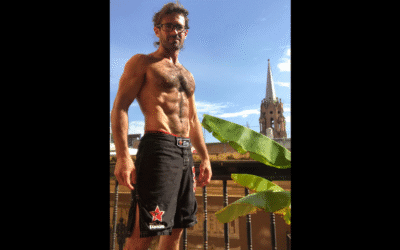Boxing training is great for fitness, self-defense, competition, or just for fun. This article discusses basic boxing offensive and defensive techniques in detail.
Basic Boxing Offense
1) Straight Punches
1) Jab – lead hand straight punch
- Step with same side foot
- Opposite hand stays up at temple (doesn’t drop down to chin or below)
- Turn the punch over to connect with the largest two knuckles (index and middle finger)
- These are always the two knuckles you want to connect with. Connecting with the smaller knuckles can break the hand bones.
- Fully extend punch (but don’t hyperextend elbow)
- Get full extension on the jab. Jabbing at too short of range leaves the chin exposed to powerful counters (hooks)
- Punch straight ahead. Not up or down. Punching downward leaves your chin exposed. You have maximum reach, power, and effect on your jab when you punch straight ahead (not up or down).
- Shoulder of punching arm is glued to chin at the end of the punch (chin protected behind shoulder)
- Chin stays down (doesn’t come up as you throw the jab)
- Recoil quickly
- Bring your punching hand immediately back to guard. Snap it out and snap it back. Recoiling slowly or incompletely is a lazy jab and leaves you open to counters.
- Snap your hips and shoulders and when throwing the punch, then snap them back
- Eyes always on the target
- After the jab, throw another strike or make a defensive movement. Don’t just stand there.
- Whether you step or not, and how far you step, depends on how far you are from the target. You want to connect with the target where your jab is at full extension for maximum effect.
- Variations
- Snap jab – focus on speed
- Power jab – focus on power, step-in (guard buster)
- Double jab – first jab focus on speed, second on power
- Angle jab – step forward with back foot as you jab (step at 45 degrees to create angle on opponent)
- Can slip at the same time (jab + slip + angle step)
- Jab to body – bend your knees and drop your hips to jab to the body. Don’t lean forward or bend forward at the hips. Sit your hips down and punch directly forward, so that your chin is protected by your punching shoulder. Don’t punch downward, this leaves your chin exposed. Keep your chin back behind your punching shoulder (don’t lift your chin or dive in with it). Target: solar plexus.
- Jab + slip: Dip your head off the center line to your non-punching side as you jab. Don’t let non-punching hand drop. Goal is to slip the straight punch and land the jab at the same time. Eyes always on the target.
- Common mistakes
- Not recoiling quick enough
- Not recoiling all the way (leaving the jab out there)
- Dropping the punching hand before throwing the jab (loading with the hand).
- Load by rotating the hips and shoulders, not by dropping the hand.
- Dropping the non-throwing hand as you jab (below the temple)
- Not fully extending jab (jabbing at too short of range and leaving chin exposed)
- Flailing elbows
- Elbows should fire straight forward on straight punches. They do not bow out to the sides on straight punches.
- Being tight throughout the movement. (Keep your muscles loose and relaxed all the way through the punch until the very end, then tighten the fist at impact)
- Snap punches, don’t push them. Clench your fist and snap it only at the last moment.
- Jabbing downward instead of straight ahead (thus leaving the chin exposed)
- Jabbing downward is an easy habit to fall into if you’re taller
- Bending or leaning forward at the waist (thus exposed to uppercut)
- Lunging forward with the chin up
- Staying still after throwing the jab (not throwing anything behind it or making a defensive move)
2) Cross – rear hand straight punch
- Opposite hand stays up at temple (doesn’t drop down to chin or below)
- Pivot same side foot (rear foot) as you punch (turn it in)
- Turn your fist over to connect with the largest two knuckles (index and middle finger)
- These are always the two knuckles you want to connect with. Connecting with the smaller knuckles can cause the hand bones to break.
- Fully extend elbow (but don’t hyperextend it)
- Get full extension. Throwing straight punches at too short of range leaves the chin exposed to powerful counters (hooks)
- Punch straight ahead. Not up or down. Punching downward leaves your chin exposed. You have maximum reach, power and effect on your cross when you punch straight ahead (not up or down).
- Shoulder of punching arm is glued to chin at the end of the punch (chin protected behind shoulder)
- Chin stays down (doesn’t come up as you throw the punch)
- Recoil quickly
- Bring your punching hand immediately back to guard. Snap it out and snap it back. Recoiling slowly or not completely is a lazy punch and leaves you open to counters.
- Snap your hips and shoulders and when throwing the punch, then snap them back
- Eyes always on the target
- Whether you step or not, and how far you step, depends on how far you are from the target. You want to connect with the target with your cross is at full extension for maximum effect.
- Variations
- Double cross – recoil all the way between punches
- Angle cross – step forward at 45 degrees with your lead foot as you throw the cross (to create angle on opponent)
- Can slip at the same time (cross + slip + angle step)
- Cross to body – bend your knees and drop your hips to cross to the body. Don’t lean forward or bend forward at the hips. Sit your hips down and punch directly forward, so that your chin is protected by your punching shoulder. Don’t punch downward, this leaves your chin exposed. Finish with your chin behind your punching shoulder (don’t lift your chin or dive in with it). Target: solar plexus.
- Cross+ slip: Dip your head off the center line to your non-punching side as you throw the cross. Don’t let non-throwing hand drop. Goal is to slip the straight punch and land the cross at the same time. Eyes always on the target.
- Common mistakes
- Not recoiling quick enough
- Not recoiling all the way (leaving the punch out there)
- Dropping the punching hand before throwing the cross (loading with the hand).
- Load by rotating the hips and shoulders, not by dropping the hand.
- Dropping the non-throwing hand as you throw the cross (below the temple)
- Not fully extending cross (punching at too short of range and leaving chin exposed)
- Flailing elbows
- Elbows should fire straight forward on straight punches. They do not bow out to the sides on straight punches.
- Being tight throughout the movement. (Keep your muscles loose and relaxed all the way through the punch until the very end, then tighten the fist at impact)
- Snap punches, don’t push them. Clench your fist and snap it at the last moment.
- Punching downward instead of straight ahead (thus leaving the chin exposed)
- Bending or leaning forward at the waist (thus exposed to uppercut)
- Lunging forward with the chin up
2) Hooks
- Rotate your hips
- Snap your elbow up
- Turn your fist over (twisting motion)
- Pivot your same side foot
- For kickboxing: do not pivot your foot on hooks in kickboxing or muay thai because you have to defend kicks. You can still generate a lot of power in your hooks without the foot pivot. The foot pivot is correct form for boxing, but incorrect for kickboxing or muay thai.
- Get your elbow up on the hooks (high elbow = more power, less chin exposure)
- Finish with your chin tucked behind your punching shoulder and your opposite hand up at your temple
- Punch ends at the contact point (directly in front of your face) and recoils immediately. Don’t over-rotate or follow through.
- Connect with the largest two knuckles (index and middle)
- Whether you land the punch with the palm facing down or facing towards you, either is correct, but connect with the biggest two knuckles
- Hooks, straight punches and uppercuts should all be landed from the same distance. Visualize a nickel at the end of your jab. You should be able to hit that nickel with a straight punch, hook or uppercut.
- Can throw hooks with or without a step depending on the distance. You want to connect at the distance where you have full extension on your punch because that’s where you have the most power.
- Common mistakes
- Dropping the non-throwing hand (leaving chin exposed)
- Not getting your elbow up high enough (loses power and leaves chin exposed)
- Over rotating (excessive follow through)
- Not recoiling quick enough
- Not recoiling completely (leaving the punch hanging)
- Lunging forward as you punch (leading with the chin)
- Looping the hook (loading with the hand). Load by rotating the hips and shoulders, not by reaching out with the hand.
- Variations
- Hook to the body – Turn over the hook to the body, same as the head hook.
- Targets:
- Floating ribs (bottom ribs – the smaller rib bones)
- Liver (right side of body, at and just below bottom of ribs)
- Attack by coming up and under ribs at 45 degree angle on opponent’s right side
- Solar plexus (center of chest, just below sternum)
- Good hook target if you are at an angle to your opponent
- Finish with chin behind punching shoulder
- Can sit your hips down to avoid having to reach too far down with your shoulder (thereby exposing the chin above the shoulder)
- Good to follow a body hook or series of body hooks with a hook or uppercut to the head. Don’t just stand there after throwing a body hook – either throw another attack or make a defensive movement.
- Common mistake: diving in with the chin (leading with the chin). Keep your chin hidden behind your shoulder.
- Targets:
- 45 – halfway between hook and uppercut (comes in at 45 degree angle)
- Targets liver and floating ribs. Dig the largest two knuckles (index and middle) on impact.
- Overhand – hook that comes from over the top of the shoulder
- Throw the hook overhand to come over the opponent’s guard
- Shoulders will tilt and head will naturally dip off the center line
- Eyes always on the target
- Twist your fist over and connect with the largest two knuckles
- Opposite hand stays up (don’t let it drop)
- Check hook – step back and to the side with your same side foot as you throw the hook. Get the head off the center line to avoid straight punches.
- Hook to the body – Turn over the hook to the body, same as the head hook.
3) Uppercuts
- Same distance as hooks and straight punches
- Palm facing in (towards you) at point of impact. Rotate the hand. Power comes from snapping the rotation.
- Connect with biggest two knuckles (index and middle)
- Stop at point of contact (directly in front of your face) and recoil immediately. Do not overextend the uppercut too high.
- Stay loose until the very end of the punch and only tighten the fist at the very end
- Common mistakes
- Dropping the punching hand before throwing the uppercut (loading with the hand).
- Load by rotating your hips and shoulders, not by dropping your hand
- Throwing uppercuts too short (you have max power at full extension)
- Not recoiling fast enough
- Dropping non-punching hand below temple
- Dropping the punching hand before throwing the uppercut (loading with the hand).
- Variations
- Uppercut to the body – use when opponent is bent forward
Basic Boxing Defense
- Evading is always superior to parrying. Parrying is always superior to blocking. Blocking (even partially) is always superior to taking a clean shot. Evading is your first line of defense, parrying the second and blocking the third. Partially evading or defending a shot is always superior to taking a clean shot.
1) Evading (head movement)
- Think of head movement as a full body movement, not just a head movement. Slips, rolls and pull backs all require you to move your whole body.
- Head movements
Pull back
- Front hand drops (only slightly)
- Head pulls straight back
- Chin stays down behind shoulder (don’t allow it to come up)
- Back hand stays up at temple
- Pull back just out of range. Don’t exaggerate the movement as pulling too far back will leave you off balance.
- Bring front hand immediately back up as your head recoils. Don’t leave it down. Drop the front hand only slightly, not too far.
- If you need to pull back twice in a row, step back with your back foot as you pull back the second time
- Pull back from straight punches, hooks or uppercuts
Slip
- Bend your knees
- Turn your hips and shoulders
- Dip your head off the center line
- Keep both hands up (don’t let either hand drop while slipping)
- Slip straight punches
- Slip to the outside of the punch
- Slipping to the inside can be dangerous if there another punch coming behind it
- Practice slipping while stepping forwards and backwards
Roll
- Roll under hooks. You can also roll under straight punches, but generally you slip straight punches and go under hooks.
- Bend your knees, drop your hips and roll your head under the centerline from one side to the other.
- Don’t bend at the waist. Bend your knees and sink your hips to go under
- Eyes on the target at all times (don’t look down)
- Beware that you are vulnerable to the uppercut while rolling (especially if you bend forward at the waist).
- Keep both hands up
- Practice rolling while stepping forwards and backwards
- Kickboxing and Muay Thai: Generally don’t roll in kickboxing or Muay Thai because of the knees. If you do roll in kickboxing or Muay Thai, do so only slightly – rolling too low makes you vulnerable to knees or kicks to the head.
2) Parrying
- Parry straight punches (jab or cross)
- A parry is an advanced block. You catch + deflect the punch as it comes in.
- Keep a tight guard and use minimum movement
- Keep your hand close to your face when parrying. Don’t reach out to far.
- Let the punch get to you, don’t chase it.
- Keep the parrying motion as short as possible, no extra motion
- Hit the punch down or to the side with your hand
- Can also use your forearms to deflect punches
- Parry with the same side hand that the punch is coming from (parry their right with your left hand, and their left with your right hand)
- Variation: slip + parry – slip while parrying (dip your head off the centerline to the outside while parrying the punch to the inside)
- Parrying straight punches to the body: you can parry straight punches to the body, but be aware that your hand has to travel farther to reach a body punch, thus leaving your head more exposed.
- You can evade body shots by pulling the hips back, or block/deflect them with your forearms and elbows.
3) Blocking
- Head block (blocking head punches)
- Block by raising your hand up to your head (left hand to block right punches, right hand to block left punches)
- Key is to keep your hand pressed tightly against your head. If there is a gap between your hand and your head, then you will hit yourself and your block will not be effective.
- Use your hand, shoulder, elbow and/or forearm to block or deflect the punch
- When blocking a hook, make sure your temple and ear are protected. Do not allow the hook to sneak behind the guard.
- Eyes always on the target
- Make sure your feet are balanced. You must have a strong base or you can still be knocked off balanced by a punch, even if you block it.
- Body block (blocking body punches)
- Drop the elbow down to cover the floating ribs and liver (left elbow to block right punches, right elbow to block left punches)
- Bring elbow immediately back up afterwards, because dropping elbow leaves chin exposed
- Crunch down as you block to keep your chin behind your glove, thereby minimizing chin exposure





0 Comments